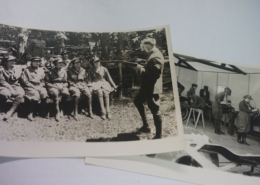3 Ways to Cover “The First Oval Office” in its Sole D.C. Appearance

(L) Washington’s Revolutionary War Encampment in 2015 (credit: The First Oval Office). (R) First Oval Office watercolor by Peter Waddell.
A Tudor Place Bicentennial Event
George Washington Parke Custis’s most famous acquisition from his grandparents’ home at Mount Vernon was Gen. Washington’s Revolutionary War “marquee,” a hard-used tent in which Custis hosted parties and commemorations. But Custis’s Lee descendants lost it when they sided with the Confederacy, and after the Federal government took the tent for safekeeping, it took Lees descendants more than a century to reclaim it, later selling it for public exhibition. While the original undergoes conservation, reproductions of Washington’s headquarters tent and the dining tent that stood alongside are on tour, coming to just one site in the capital region for just one weekend, and featured during two public events.
Washington, DC –On April 29 and 30, George Washington’s Revolutionary War headquarters and dining tents will be the site of three novel events at Tudor Place in Georgetown, during the exhibition’s only stop in the Washington, D.C., region. On the Tudor Place South Lawn, visitors can tour the scrupulous reproduction of “The First Oval Office” and many of its furnishings, experiencing the linen-walled spaces where General Washington and his staff slept, ate, and strategized during critical moments of the Revolutionary War.
Tudor Place has invited the public to view the tent in an adults-only “sneak peak” evening party, April 29, and a day-long “encampment,” April 30, featuring the tents, colonial crafts and activities, and story-telling and history discussion about the roles of women and African-Americans during the Revolutionary War. Also April 30, a private dinner for donors, served in the tent, will feature a menu and entertainment reminiscent of how Washington would have dined.
WHAT
Special exhibition of the dining marquee, office, and sleeping quarters that served as George Washington’s Revolutionary War headquarters. The tents will open first for a “Sneak Peek” Tudor Nights cocktail party for adults, Friday evening, April 29, with appearance by costumed interpreter “Mrs. Martha Peter,” founder of Tudor Place, who will chat and answer questions about life on the estate, 18th-19th century politics and events, and early times in the nation’s capital. On Saturday, April 30, guests of all ages can tour the tents during the Revolutionary War Encampment program with activities and features including Mrs. Peter and soldier-enactors, storytelling, and colonial crafts.Saturday evening, April 30, donors will enjoy a historically themed private banquet served in Washington’s reproduction dining tent.
Press are invited to cover any or all three of these events.
WHEN
- 6:30 – 8:30 pm, Friday, April 29 (Tudor Nights “Sneak Peak” private event)
- 10 am – 4 pm, Saturday, April 30 (public viewing)
- 6 pm, Saturday, April 30 (private donor banquet)
WHERE
Tudor Place
1644 31st St. NW
Washington, DC 20007
FEATURING
- Revolutionary War Encampment featuring George Washington’s Revolutionary headquarters marquee and accompanying dining and baggage tent
- Costumed interpreters to include Tudor Place founder “Mrs. Martha Peter,” played by award-winning actress and Smithsonian scholar Mary Ann Jung (Friday evening + Saturday afternoon), and two costumed revolutionary war interpreters (Saturday daytime).
- In the HQ tent, furnishings including reproductions of Gen. Washington’s traveling camp stools based on the original in the collection at Tudor Place, one of two remaining from the original set of 18.
- Candle-making and tea-blending demonstrations and activities (Saturday daytime)
- Interactive storytelling and discussion about roles of women and African Americans in the Revolutionary War (Saturday daytime)
- Cocktails and hors d’oeuvres, tours of the tent and garden strolls by twilight, and conversation with Mrs. Peter during the Tudor Nights Tent “Sneak Peek” (Friday evening)
- Gala sit-down dinner catered with a menu based on cuisine Washington and his officers would have recognized (Saturday evening)
 https://tudorplace.org/wp-content/uploads/2023/12/Ancestral-Spacse_web-scaled.jpg
1707
2560
Comms2018
https://tudorplace.org/wp-content/uploads/2020/01/2020-01-23-300x155.png
Comms20182024-03-29 13:55:212024-03-29 13:55:21Ancestral Spaces: People of African Descent at Tudor Place (Tickets for April 30 – May 5)
https://tudorplace.org/wp-content/uploads/2023/12/Ancestral-Spacse_web-scaled.jpg
1707
2560
Comms2018
https://tudorplace.org/wp-content/uploads/2020/01/2020-01-23-300x155.png
Comms20182024-03-29 13:55:212024-03-29 13:55:21Ancestral Spaces: People of African Descent at Tudor Place (Tickets for April 30 – May 5) https://tudorplace.org/wp-content/uploads/2023/12/thumbnail_Website-Image-2.jpg
1280
1920
Comms2018
https://tudorplace.org/wp-content/uploads/2020/01/2020-01-23-300x155.png
Comms20182023-12-08 12:12:582023-12-15 10:49:49Tudor Nights: Up in Arms: A Family’s Service
https://tudorplace.org/wp-content/uploads/2023/12/thumbnail_Website-Image-2.jpg
1280
1920
Comms2018
https://tudorplace.org/wp-content/uploads/2020/01/2020-01-23-300x155.png
Comms20182023-12-08 12:12:582023-12-15 10:49:49Tudor Nights: Up in Arms: A Family’s Service https://tudorplace.org/wp-content/uploads/2024/01/Dirt-Diggers-scaled.jpg
2560
1920
Janet Wall
https://tudorplace.org/wp-content/uploads/2020/01/2020-01-23-300x155.png
Janet Wall2024-01-19 11:52:142024-01-19 16:54:56Dirt Diggers | Garden Volunteering
https://tudorplace.org/wp-content/uploads/2024/01/Dirt-Diggers-scaled.jpg
2560
1920
Janet Wall
https://tudorplace.org/wp-content/uploads/2020/01/2020-01-23-300x155.png
Janet Wall2024-01-19 11:52:142024-01-19 16:54:56Dirt Diggers | Garden Volunteering https://tudorplace.org/wp-content/uploads/2023/12/Ancestral-Spacse_web-scaled.jpg
1707
2560
Comms2018
https://tudorplace.org/wp-content/uploads/2020/01/2020-01-23-300x155.png
Comms20182024-04-02 13:52:382024-04-02 13:52:38Ancestral Spaces: People of African Descent at Tudor Place (Tickets for May 7 – May 12)
https://tudorplace.org/wp-content/uploads/2023/12/Ancestral-Spacse_web-scaled.jpg
1707
2560
Comms2018
https://tudorplace.org/wp-content/uploads/2020/01/2020-01-23-300x155.png
Comms20182024-04-02 13:52:382024-04-02 13:52:38Ancestral Spaces: People of African Descent at Tudor Place (Tickets for May 7 – May 12)












